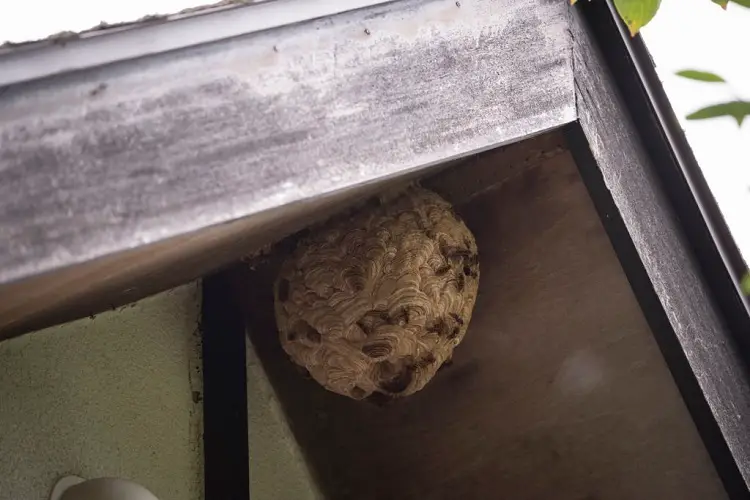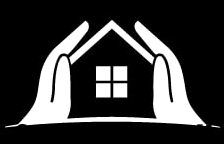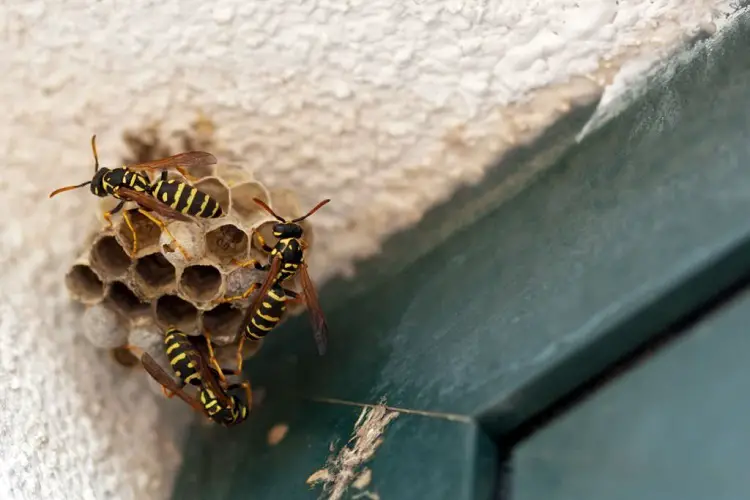If you’ve ever dealt with a wasp infestation, you know how frustrating and dangerous it can be. Wasps are ferocious insects that can sting repeatedly, causing pain and swelling like honey bees, but they’re different.
They can also pose a serious health challenge to people with allergies. Getting rid of wasps can be difficult because they can become aggressive when threatened.
If you’re thinking of how to get rid of wasps within your home or an enclosed space, here are some steps you can take to safely and effectively remove and prevent future wasp infestations in your environment.
- Identify the cracks and holes and seal them up.
- Seal food sources
- Regularly inspect your tree branches, eaves, and overhangs for potential nesting sites.
- Use natural deterrents
- Call for professional assistance.
How To Know You’re Dealing With A Wasp Infestation
Early detection and intervention are often much more effective in eliminating wasp infestation.
And because they are similar in appearance, wasps are to bees, many people often have no idea which they’re dealing with.
Nesting sites
Nesting sites are among the most common ways to know you have a wasp infestation on your property.
Wasps build their nests in sheltered areas protected from predators and harsh environments.
If you find a nest or cluster of nests in areas like the attic, eaves, porches, or trees, best believe you have a wasp infestation.
There are different types of insect nests. A wasp nest resembles a light, papery structure hanging from a tree branch or a corner.
Increased Wasp activity
Another common pointer is an increased wasp activity. If you notice many wasps around your property in specific areas, that could be your sign of a wasp infestation, and there’s probably a nest nearby.
Also, wasps are more active during the day, so you’ll likely see them flying around during this time. Stay away from any area you suspect to host a wasp nest until a professional deals with it.
Some species of wasps use wood fibers to build their nests, unlike some species of wasps, which, for example, use dirt.
They remove these fibers from tree trunks, fences, and garden stakes or if you use a lot of wooden structures around your property.
Pay attention to any signs of chewed wood, as these could be clues to the presence of wasps on your property.
Also, remember that chew marks and tunnels could mean the presence of other common household pests, such as termites and ants.
Dead Insects
Wasps prey on weaker insects, and depending on their strength, these insects often do not survive, so you may find a pile of dead insects in your house.
You may find flies, bees, or other dead insects piling near their nests or other areas where the wasps are present.
Aggressiveness
Wasps become hostile and aggressive when they perceive any threat and can sting repeatedly to fight off any disturbance from a predator.
If wasps attack you or someone close to you, leave that area and call for help from professional pest control centers.
And stay away until the area is cleared. Wasps can be quite dangerous, especially when you attempt to clear their nests.
It is advisable to seek professional assistance instead of handling the situation yourself.
How To Get Rid Of Wasps in Your House

Once you notice a wasps infestation, you must act quickly to prevent them from saturating your property.
Call for professional pest control services if you realize that the nests are many and the situation may be overwhelming.
Otherwise, here are some steps to take to get rid of wasps infestation in your home:
1. Identify the Nests
Locate the wasp nests if you can. This will help you determine the extent of the infestation and the best approach to removal.
2. Protect Yourself
Wear protective clothing like long sleeves, pants, gloves, and a veil, mask, or hat to protect your face and head, especially if attempting to remove it yourself.
3. Natural Deterrents
You can use several natural deterrents to keep wasps away from our property. These include hambling up fake nests, using essential oils like peppermint or clove, and resetting out sliced cucumber or citrus fruit.
4. Seal Food Sources
Since you know that wasps are attracted to sweet and sugary foods, seal all food sources, especially when eating outdoors. These include pet foods, fruits, and other sweet-smelling foods.
5. Remove Food Scraps
It is advisable to promptly clean up any spills, crumbs, or food residue that may have fallen on surfaces, as these can attract wasps.
These insects are known to be drawn to sweet and sugary substances and protein-based foods, so it is crucial to ensure that any remnants are thoroughly wiped away.
Taking these precautions can help prevent wasps from becoming a nuisance or even posing a danger to those around you.
6. Keep All Trash Cans Covered
Ensure your garbage cans are tightly covered with lids and are empty regularly to prevent attracting wasps.
7. Set Traps
You can set up wasp traps using sweet baits. However, be cautious, as these traps can also attract more wasps, which can be overwhelming.
8. Destroy the Nests
If the nest is in a manageable location and you’re confident, you can try to remove or destroy the net.
Use a wasp-specific insecticide spray during the evening or early mornings when wasps are less active.
Approach the nest cautiously and apply the spray according to the product instructions.
Wait a day or two to ensure the wasps are dead before removing the nests.
9. Professional Assistance
If the nest is large, in a difficult-to-reach area, or you are uncertain of your ability to handle the situation, it’s best to hire a professional pest control service. They have the equipment, experience, and knowledge to remove wasp nests safely.
How to Get Rid of Wasps in Your Yard
1. Remove Attractants
A great method to stop wasps from building nests in your yard is to eliminate anything that might attract them.
This can involve removing open garbage cans, uncovered food, and sweet-smelling plants or flowers.
By reducing the number of food and water sources, you can make your yard less attractive to wasps.
2. Set Up Wasp Traps
Setting up traps can be effective in eliminating wasps in your yard. You can use different traps, such as bait traps that use sweet liquid or meat-based baits to lure the wasps or light traps that use UV light to attract and catch them.
To get the best results:
- Place the traps in areas where the wasps are most active but away from where people are likely to spend time.
- Remember that while the traps work well, they can collect dead wasps and may not be visually appealing.
- It’s best to hang bug repellents far away and replace them regularly to keep your outdoor living spaces free from pests.
3. Hang Wasp Deterrents
There are various methods to prevent wasps from constructing nests in your yard.
One of these is using fake wasp nests, which mimic real wasp nests and discourage other wasps from entering the vicinity. Decoy animals or birds may also be effective in scaring off wasps.
4. Spray Wasp Nests
If you discover an active wasp nest close to your home or property, it’s important to use commercially available wasp nest spray to get rid of it.
To ensure optimal results, it’s advisable to wear protective clothing, like long sleeves, and spray the nest during late hours when the wasps are inactive and the queen and workers are present.
We recommend purchasing a wasp spray with a long-range nozzle for effective coverage. You can spray the nest multiple times over a few days if required.
5. Use a Soap and Water Mixture
If you are looking for an alternative to insecticides, you can use soap and water to remove small wasp nests.
Mix two tablespoons of dish soap with water in a spray bottle and spray the nests. The wasps will be killed instantly as the mixture will block their breathing pores.
6. Use Homemade DIY Traps
A homemade wasp trap can be easily assembled by removing the top of a large soda bottle and filling the bottom with a blend of soda or fruit juice and liquid soap.
Once the trap is turned upside down and the top is reattached, it can be hung in your yard for optimal use.
7. Kill Individual Emerging Wasps
You can use store-bought wasp killer sprays to get rid of individual wasps. Simply follow the instructions on the insecticide label you purchase and spray the wasps as soon as you see them.
8. Treat Future Nesting Areas
You can treat potential nesting sites with residual liquid pesticides to prevent wasps from building nests. You can purchase these pesticides from your local home improvement or hardware store.
Spray these areas, such as your deck, pool, patio, and wood fence, to keep wasps away and avoid future nest building.
9. Call For Professional Assistance
If the techniques mentioned earlier fail to eliminate wasps from your yard, it’s best to contact a professional pest control company.
They possess the expertise to offer a more comprehensive and efficient solution to your wasp issue.
The pest control experts can identify the type of wasp in your yard, decide on the optimal strategy, and provide a customized remedy to eradicate the pests permanently.
This is crucial, particularly if you’re dealing with extensive outdoor wasp colonies that may pose a risk and can’t be managed alone.
How to Get Rid of Wasps Nest
Removing wasp nests may seem easy, but it can be complicated as angry wasps swarm and sting.
To ensure your safety and achieve effective results, it is advisable to spray the nest with store-bought wasp killer for at least 24 hours before attempting to remove it.
If you notice any wasp activity after the first spray, apply the spray again. After the nest appears to be inactive, follow these guidelines:
- It is recommended to approach the nest in the evening when you are certain that all the wasps inside have been eliminated.
- Cover the nest with a garbage bag.
- Seal the bag around the nest after pulling it from the tree or wall.
- Place the garbage bag and nest in a tight-fitting outdoor trash can.
If the nest is in a difficult-to-access area, refrain from attempting to remove it alone. It is advisable to contact Smith’s Pest Management to have the nest removed safely on your behalf.
Read Also: Does Killing a Wasp Attract More? Explained
What is The Most Common Type Of Wasp?
Be cautious around wasps, hornets, and yellow jackets, as they can all deliver painful stings. This is especially true for those allergic to them, as their stings can be life-threatening.
Even if you’re not allergic, getting too close to a wasp nest can still be dangerous. Wasps will quickly swarm out and sting anything nearby, sometimes in large numbers.
It’s worth noting that different species of wasps have different temperaments – some are very aggressive, while others are more docile.
For example, the mud dauber is a species of wasp that preys on and consumes other pests, like spiders.
Mud daubers are generally tolerable if they are in a location where they won’t be disturbed by people or pets.
They also assist in controlling the pest population. Identifying the type of wasp you’re dealing with is crucial due to their diverse behaviors.
Here are the four most prevalent wasp species found in the United States.
1. Yellow Jackets
Did you know that yellow jackets are a type of social wasp with a distinct black and yellow striped body? They can grow to about 3/8 to 5/8 inch in length and build nests containing hundreds or thousands of wasps.
It’s important to be cautious around yellow jackets as they are more aggressive than other types of wasps and can sting repeatedly if they feel threatened.
These wasps can build their nests in various locations, including in the ground, trees, and under eaves or attics.
They are attracted to sweet foods and can become more aggressive in late summer and early fall as they search for food before winter.
2. Mud Daubers
Did you know mud daubers are solitary wasps constructing their unique nests from mud?
These wasps usually have black or metallic blue bodies with bright yellow patterns on their thorax and legs.
They have a thin, elongated shape. Unlike yellow jackets, mud daubers are not hostile and rarely sting humans.
You can find their nests in sheltered areas like under eaves, attics, or building walls. Mud daubers are drawn to spiders and will immobilize them to nourish their offspring.
3. Paper Wasps
The name “paper wasp” comes from their nests, made of wood fiber taken from plants and chewed into hexagonal chambers resembling paper.
These wasps are usually brown or reddish-brown with a slim body and yellow to red markings. While not typically aggressive, they will defend their nest if threatened.
Paper wasps are prevalent across the United States and usually build their nests in secure spots, such as under eaves, in trees, or near buildings for protection.
4. Bald-Faced Hornets
Be cautious of bald-faced hornets, as they can be quite aggressive. These insects are predominantly black with white or ivory markings and live in large colonies.
They are considered social insects and often build round, papery nests in trees and bushes. Therefore, being mindful of their presence in your garden is important.
5. European Hornets
European hornets are typically brown with yellow stripes and only become aggressive if threatened.
Their nests can be found in various locations, such as barns, attics, and abandoned bee hives. According to the University of Maryland Extension, the average nest houses 200 to 400 workers.
Read Also: Can you kill a wasp with a fly swatter?
Difference Between Wasps And Bees
Albeit alike, honey bees and wasps are distinct insects with similar physical traits.
They both have painful stingers that can cause severe reactions to their victims.
Both of them possess a yellow and brown/black stripe on their shells. As much as they look alike, bees and wasps are different types of insects with differences in their key features.
Here are some differences between the two insects:
| Key features | Wasps | Bees |
| Appearance | They are omnivores. They feed on insects, fruits, and sugary substances. | They are omnivores. They feed on insects, fruits and sugary substances. |
| Diet | They have a barbed stinger that detaches and is left in the victim’s skin. | They are herbivores, |
| Sting | They have a smooth stinger that is used repeatedly. | They are omnivores. They feed on insects, fruits, and sugary substances. |
Read Also: How Mice Gain Entry into Upstairs Apartment and How To Prevent It
5 Things That Attract Wasps To Your Property
Like many other insects that move in colonies, wasps are attracted by different things and cast a nest where they find comfort.
Understanding what attracts them to your home will help you to take the rightful steps in preventing an infestation or a reinfestation if you’ve dealt with it before.
Here are five common things that can attract wasps to your home:
Food sources
Wasps are attracted to sugary and high-protein foods. If you have an open food container or spilled sweet and proteinous food, wasps will be attracted to that area and cast a nest if the food is constant.
These foods include pet food, fruit trees, or open trash cans. Always empty your trash can and keep it covered. Keep our garden clean and free of food debris.
Water
Water is a major attraction to wasps. Just like many other living things, wasps need water to survive. If you have standing water in your yard, like ponds, bird baths, or stagnant water, wasps may be attracted to such a place.
Regularly change the bird water and fix any leakages in the plumbing system to prevent standing water.
Colors
Wasps are attracted to bright colors like yellow and white. You may find wasp nests in your home if you have any bright flowers or decor with these colors.
Flowers
Wasps are attracted to flowers for their bright colors and sweet scent. You can attract wasps if you have flowers with sweet scents planted around your yard or wear perfumes with sweet scents.
Read Also: Do LED Lights Attract Spiders?
Conclusion
These steps guide you on getting rid of wasps in your home if you intend to do it yourself. Otherwise, the professionals used to the practices know the type of tools and how best to use them, which may not necessarily tally with your steps.

